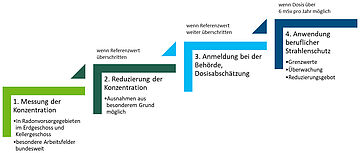Protection against radon in workplaces
A tiered approach was chosen so that protection measures only have to be implemented in workplaces where high radon concentrations are present. The standard for workplaces is the annual average reference level of radon-222 activity concentration (or radon concentration) of 300 becquerels per cubic metre of air (Section 126 of the Radiation Protection Act). This covers all indoor workplaces and workplaces listed in Annex 8 of the Radiation Protection Act. In accordance with the Radiation Protection Act, a workplace is any place at which a worker is regularly or repeatedly present during the performance of his or her occupational duties. The aim of the tiered approach is to generally reduce the radon concentration in workplaces. The tiers are described below:

Tiered scheme for reducing radon concentrations in workplaces:
1. Measure the concentration (in radon prone areas, at ground floor and basement levels; nationally in specific fields of work)
2. (If reference level is exceeded) reduce the concentration (exceptions possible with specific reasons)
3. (If reference level continues to be exceeded) registration with the authority, dose estimate
4. (If dose potentially exceeds 6 mSv per year) take occupational radiation protection measures (limit values, monitoring, reduction)
1. Measuring radon concentration
The radon concentration in the air must be measured if the workplace is in a radon prone area, at ground floor or basement level, or if the workplace is listed in Annex 8 to the Radiation Protection Act because a high radon activity concentration is expected. This is the case, for example, in mines, drinking water treatment and supply facilities and radon baths,also outside of radon prone areas (Section 127 Radiation Protection Act).
Measurement is carried out over a period of 12 months (Section 155 Radiation Protection Act) so that seasonal fluctuations are recorded in the annual average. The measurement is to be calculated within 18 months after identification as a radon prone area with activity commencing at a workplace. In the case of workplaces listed in Annex 8 of the Radiation Protection Act, the measurement must be made within 18 months of activity commencing at the workplace (Section 127 Radiation Protection Act).
Various measuring equipment is available. Equipment should be requested from a provider recognised by the Federal Office for Radiation Protection (BfS) and used in accordance with its instructions (Section 155 Radiation Protection Ordinance) in order to ensure the quality of the measurement and the conclusiveness of the final result. The list of recognised providers of radon measurements can be viewed on the BfS website.
2. Reducing radon concentrations
If the annual average radon concentration in a workplace exceeds the reference level according to Section 126 of the Radiation Protection Act, the party responsible for the workplace must immediately take action to reduce the radon concentration in the air and achieve concentrations below the reference level (Section 128 Radiation Protection Act).
Reduction measures can range from simple logistical changes to comprehensive decontamination efforts. The measures must be well planned and tailored to the on-site situation. It can be helpful to consult with people specially qualified in radon protection for this purpose in order to choose appropriate and effective measures.
The party responsible for the workplace must also carry out additional measurements to check whether the reduction measures have been sufficiently effective and are below reference level. The follow-up measurement must be provided within 30 months after it has been determined that the reference level was exceeded (Section 128 Radiation Protection Act).
3. Registering with the authority, estimating dose
The party responsible for the workplace must immediately register the workplace with the competent authority if the second measurement of the radon concentration does not reflect a concentration below the reference level (Section 129 Radiation Protection Act). Other information, such as the type of workplace, the number of affected workers, measurement results, information about measures taken and additional planned measures, should be submitted with the registration.
4. Taking occupational radiation protection measures
After registering, the party responsible for the workplace must complete an estimate of the radon-222 exposure in the workplace within six months (Section 130 Radiation Protection Act). The results of the estimate are to be recorded, submitted to the competent authority and retained for five years.
If the estimate concludes that the effective dose cannot exceed six millisieverts per calendar year, no further measures are immediately necessary. However, the party responsible for the workplace must regularly check the level of radon exposure. If the workplace has changed in a way, that a higher exposure is possible, the estimate has to be redone.
Should the estimate show that the effective dose could exceed six millisieverts per calendar year, the requirements of occupational radiation protection must be fulfilled following the standards in Section 131 of the Radiation Protection Act and Sections 157 and 158 of the Radiation Protection Ordinance. The requirements include continuous dose monitoring and regular medical exams for workers, among other measures.
